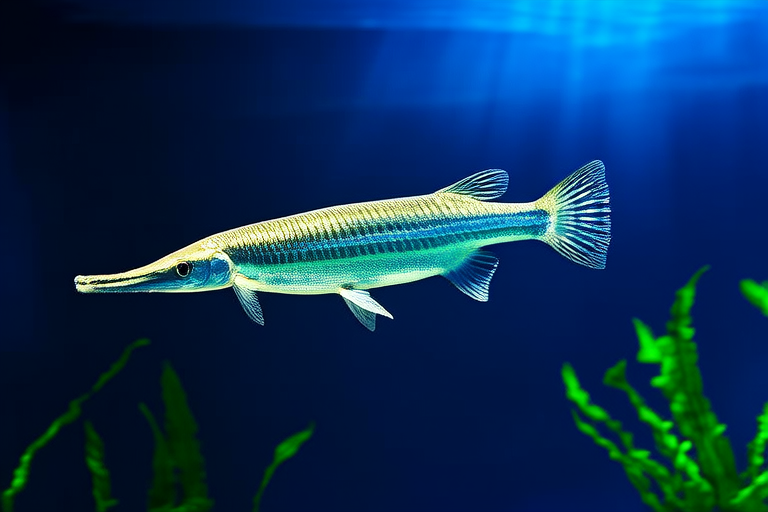Spectacular Scales: The Majestic World of Arowana
The arowana, also known as dragonfish, is a species of freshwater bony fish that commands attention with its striking appearance and regal demeanor. This article delves into the world of arowanas, exploring their physical characteristics, native habitats, behavioral traits, cultural significance, conservation status, and tips for aquarium care if kept as pets.
Physical Characteristics
Arowanas are renowned for their sleek, elongated bodies and shimmering scales that reflect light in mesmerizing patterns. Their eyes are large and prominent, providing them with excellent vision both above and below water. These fish can grow up to three feet long, making them one of the largest freshwater species found in tropical regions. Their mouths are equipped with sharp teeth, designed for catching prey, while their pectoral fins are strong and robust, enabling them to navigate through dense vegetation and swiftly pursue their quarry. The dorsal fin, which runs along the back, adds to their graceful swimming style, while the anal fin provides stability.
Native Habitats
Native to the rivers and swamps of Southeast Asia, South America, and Africa, arowanas thrive in warm, shallow waters teeming with aquatic life. They prefer environments rich in plant life, where they can hide among the foliage and ambush unsuspecting prey. The black arowana, native to Malaysia, Indonesia, and Thailand, is particularly adapted to living in murky, oxygen-poor waters, thanks to its ability to gulp air from the surface. This adaptation allows it to survive in conditions where other fish might struggle. In contrast, the silver arowana, found in the Amazon River basin, prefers clear, fast-flowing waters where it can hunt for insects and small fish.
Behavioral Traits
Arowanas are highly intelligent and social creatures, often displaying complex behaviors that captivate observers. Known as surface feeders, they exhibit a remarkable ability to leap out of the water to catch flying insects, a trait that has earned them the nickname ‘dragonfish.’ This behavior is not only impressive but also crucial for their survival, as it allows them to access food sources that other fish cannot reach. In addition to their hunting prowess, arowanas are territorial and will defend their space against intruders. However, they can also be peaceful when kept in groups, forming close bonds with their tank mates.
Cultural Significance
In many cultures, arowanas are revered for their beauty and perceived mystical qualities. In Chinese culture, the fish is considered a symbol of good luck and prosperity, often referred to as the ‘Dragon of the Water.’ It is believed that keeping arowanas in the home brings wealth and fortune, leading to their popularity as ornamental fish. In indigenous communities, arowanas hold significant spiritual value, sometimes being associated with protective spirits or deities. This reverence has contributed to the arowana’s enduring appeal, making it a sought-after species among collectors and enthusiasts alike.
Conservation Status
Despite their popularity, arowanas face numerous threats in the wild, leading to concerns about their long-term survival. Habitat destruction, overfishing, and pollution have all taken a toll on their populations, prompting conservation efforts to protect these magnificent creatures. Many countries have implemented strict regulations on the trade and sale of arowanas to prevent further declines in their numbers. Organizations dedicated to wildlife conservation are working tirelessly to restore degraded habitats and establish protected areas where arowanas can thrive without human interference. By raising awareness about the challenges facing arowanas, we can help ensure their continued existence for future generations.
Tips for Aquarium Care
If you’re considering keeping an arowana as a pet, there are several factors to consider to ensure their well-being. First and foremost, provide ample space; these fish require large tanks that allow them to swim freely. A minimum tank size of 180 gallons is recommended for a single arowana, with additional space needed for each additional fish. Maintain optimal water quality by performing regular water changes and monitoring parameters such as pH, temperature, and ammonia levels. Feed your arowana a balanced diet consisting of live or frozen foods like shrimp, worms, and small fish. Finally, create a stimulating environment by adding plenty of hiding spots and ensuring proper filtration. With the right care, arowanas can live up to 20 years in captivity, making them a rewarding addition to any aquarium.
By understanding and appreciating the majesty of arowanas, we can foster a deeper connection with these remarkable creatures and contribute to their preservation. Whether admired in the wild or cherished as pets, arowanas continue to captivate and inspire those fortunate enough to encounter them.
